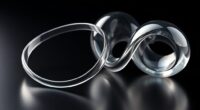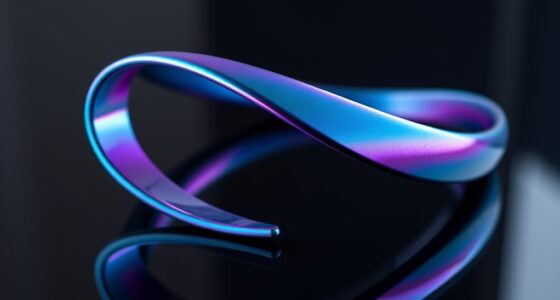In non-Euclidean geometry, you explore worlds where space curves differently. In hyperbolic space, lines diverge and triangles have less than 180°, creating infinite expansion. In elliptic space, lines eventually meet, and triangles sum to more than 180°, reflecting positive curvature. These worlds challenge your usual understanding of angles and distances, revealing fascinating properties of curved spaces. If you’re curious, there’s much more to uncover about these intriguing geometric dimensions.
Key Takeaways
- Hyperbolic geometry features triangles with angles less than 180° and diverging parallel lines, reflecting negative space curvature.
- Elliptic geometry involves positively curved surfaces where parallel lines meet and triangle angles sum more than 180°.
- Both geometries challenge Euclidean principles, altering concepts of lines, angles, and distances.
- Visualization and models help understand the curved surfaces and unique properties of hyperbolic and elliptic spaces.
- These non-Euclidean geometries are fundamental in modern physics, cosmology, and advanced mathematical research.
The Foundations of Non-Euclidean Geometry
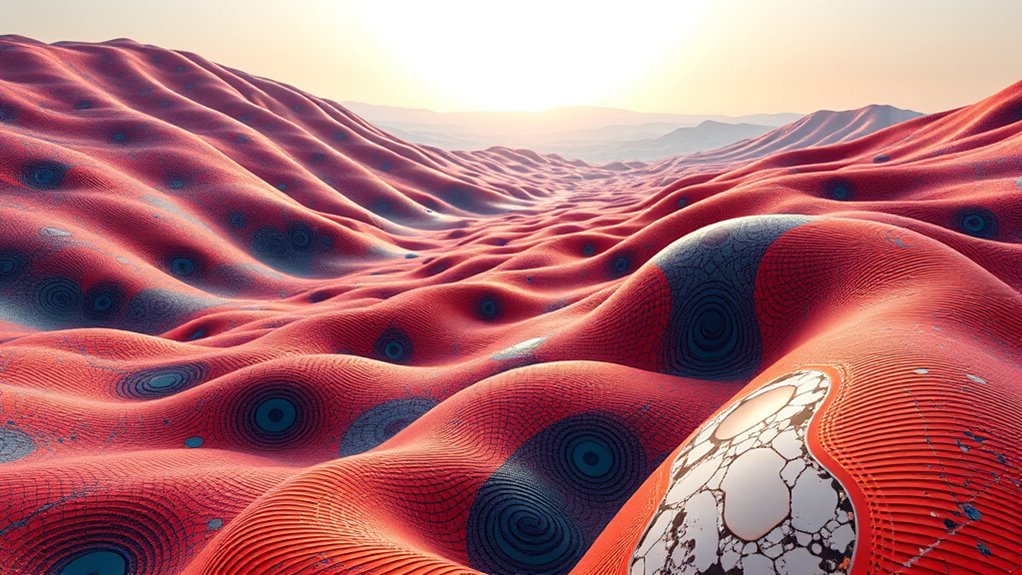
Have you ever wondered what happens when the parallel postulate doesn’t hold? In non-Euclidean geometry, the rules shift, leading to fascinating new worlds. Spherical trigonometry plays a key role here, describing triangles on curved surfaces like spheres, where the sum of angles exceeds 180 degrees. Unlike Euclidean geometry, this requires a different approach, often using non-Euclidean algebra to handle the altered relationships. This algebra modifies traditional concepts, accommodating the curvature of space. These foundations challenge your understanding of lines, angles, and shapes, revealing that geometry isn’t one-size-fits-all. Instead, it adapts to the shape of the universe, whether it’s flat, spherical, or hyperbolic. This shift opens doors to new mathematical frameworks, broadening your comprehension of space and structure beyond Euclidean confines. Recognizing the curvature of space is essential to understanding how non-Euclidean geometries operate and differ from classical Euclidean principles.
Understanding Hyperbolic Geometry

What makes hyperbolic geometry so intriguing is its departure from the familiar rules of Euclidean space. In hyperbolic planes, the sum of the angles in geodesic triangles is always less than 180 degrees. This contrasts sharply with Euclidean geometry, where the angles always add up to 180 degrees. When you study these triangles, you’ll notice they have more than one line through a point not intersecting a given line, showcasing the space’s unique properties. Hyperbolic spaces expand infinitely, yet they curve inward continuously. This curvature affects distances and angles, making the geometry feel counterintuitive but fascinating. By exploring geodesic triangles and their properties, you gain insight into how hyperbolic planes operate, revealing a world where familiar rules no longer apply. Additionally, understanding the concept of non-Euclidean geometries opens up new perspectives on the structure of space itself.
Exploring Elliptic Geometry
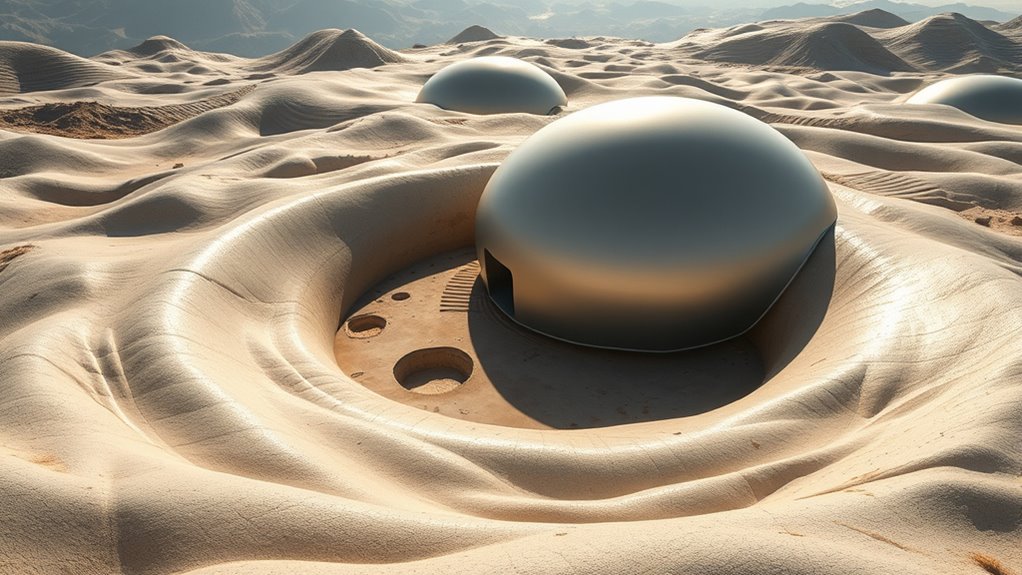
In elliptic geometry, the surface has positive curvature, which affects how points and lines behave. You’ll notice that the usual rules about parallel lines no longer apply—they tend to meet. Understanding this curvature helps you see how surface geometry differs from Euclidean space. Additionally, elliptic geometry requires a different set of cognitive and visual skills to fully grasp its unique properties.
Curvature and Surface Geometry
Elliptic geometry explores surfaces with positive curvature, where the rules of traditional Euclidean geometry no longer apply. On these curved surfaces, geodesic triangles behave differently: their angles sum to more than 180°, reflecting the surface’s intrinsic curvature. You’ll find that curvature invariants—quantities that remain constant regardless of deformation—are essential for understanding surface geometry. Specifically, consider these aspects: 1. Geodesic triangles’ angle sums exceed 180°, directly linking to the surface’s positive curvature. 2. Curvature invariants, such as Gaussian curvature, help quantify how surface bends locally. 3. The geometry’s global properties depend on this curvature, affecting shortest paths and surface behavior. Additionally, natural materials like wood and stone play a significant role in defining the character of surfaces in elliptic geometry.
Parallel Lines Behavior
Have you ever wondered how parallel lines behave on curved surfaces? In elliptic geometry, the Euclidean assumptions no longer hold. Unlike on flat surfaces, parallel lines here eventually meet, demonstrating the surface’s positive curvature. This means that what you consider parallel in Euclidean space isn’t always true in elliptic geometry. The contrast ratio on such surfaces influences how sharply images are rendered, further emphasizing the differences from Euclidean principles.
Here’s a quick comparison:
| Euclidean Geometry | Elliptic Geometry |
|---|---|
| Parallel lines stay | Parallel lines eventually meet |
| Never intersect | Do intersect at some point |
| Flat surface | Curved surface |
On curved surfaces, the behavior of parallel lines fundamentally changes, illustrating the fascinating departure from Euclidean assumptions.
Comparing Euclidean, Hyperbolic, and Elliptic Spaces

In these different geometries, parallel lines behave distinctly depending on the space’s curvature. In Euclidean space, they remain equidistant and never meet, while in hyperbolic space, they diverge, and in elliptic space, they eventually intersect. These differences highlight how curvature shapes the fundamental nature of space and geometry.
Parallel Line Behavior
Ever wondered how parallel lines behave differently across various geometries? In Euclidean space, parallel lines stay equidistant and never meet, with an angle sum of 180° in triangles. In hyperbolic geometry, they diverge, causing triangles to have an angle sum less than 180°, which affects the triangle inequality. Meanwhile, in elliptic geometry, all lines eventually intersect, and triangles have an angle sum exceeding 180°. Interestingly, the concept of curvature influences these behaviors, with negative curvature in hyperbolic space and positive curvature in elliptic space shaping the properties of lines and triangles.
Curvature and Geometry
Curvature fundamentally shapes the way geometry behaves in different spaces. In Euclidean space, zero curvature means geodesics stay straight and parallel lines never meet. Hyperbolic space, with negative curvature, causes geodesic distortion, so lines diverge rapidly and triangles have angles summing to less than 180 degrees. Elliptic space, with positive curvature, causes geodesics to converge, making triangles have angles exceeding 180 degrees. Curvature tensors quantify these differences, revealing how each space’s intrinsic curvature influences geodesic behavior. These tensors help you understand how distance, angles, and shapes transform in non-Euclidean geometries. By comparing these properties, you see how curvature fundamentally alters geometry, leading to fascinating variations from familiar Euclidean rules and shaping the unique properties of hyperbolic and elliptic worlds. Additionally, the curvature tensor provides a mathematical framework to analyze these geometric differences precisely.
Visualizing Curved Surfaces and Geodesics
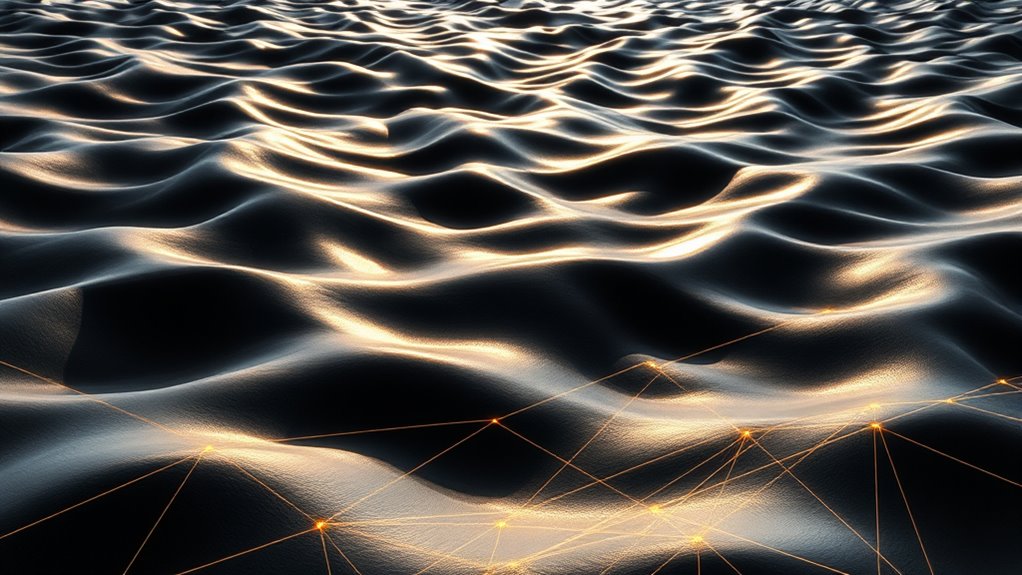
Visualizing curved surfaces can be challenging because they differ fundamentally from flat planes, but understanding their shape is essential for grasping non-Euclidean geometry. To do this, you should focus on key concepts:
Visualizing curved surfaces helps grasp non-Euclidean geometry’s fundamental differences from flat planes.
- Study spherical tessellations, which partition the surface into regular, repeating patterns, revealing how shapes fit together on curved surfaces.
- Explore geodesic nets, which show the shortest paths between points on a surface, illustrating how straight lines in Euclidean space become curved geodesics.
- Use models like globe representations or computer simulations to visualize these features in three dimensions, helping you grasp how curves and geodesics behave differently from flat geometries. Recognizing these aspects deepens your understanding of curved surfaces in hyperbolic and elliptic spaces.
- Additionally, examining the properties of geodesics can offer insight into how lines behave uniquely in non-Euclidean geometries, further enhancing visualization skills.
Applications in Modern Science and Technology

How does non-Euclidean geometry influence modern science and technology? It underpins advancements in fields like quantum mechanics and algebraic topology, shaping how we comprehend complex systems. For instance, hyperbolic spaces help model quantum states, revealing new insights into particle behavior. Algebraic topology uses curved spaces to analyze data structures and networks, improving algorithms and data analysis. Here’s a quick overview:
| Field | Application | Impact |
|---|---|---|
| Quantum mechanics | Modeling particle interactions | Better predictions, novel technologies |
| Algebraic topology | Analyzing data shape and connectivity | Enhanced data processing |
| Computer graphics | Simulating curved surfaces and spaces | More realistic visualizations |
Your grasp of non-Euclidean geometry directly influences technological progress and scientific discovery.
Additionally, curved spaces are fundamental to understanding the geometry of the universe in cosmology.
The Role of Non-Euclidean Geometry in Cosmology
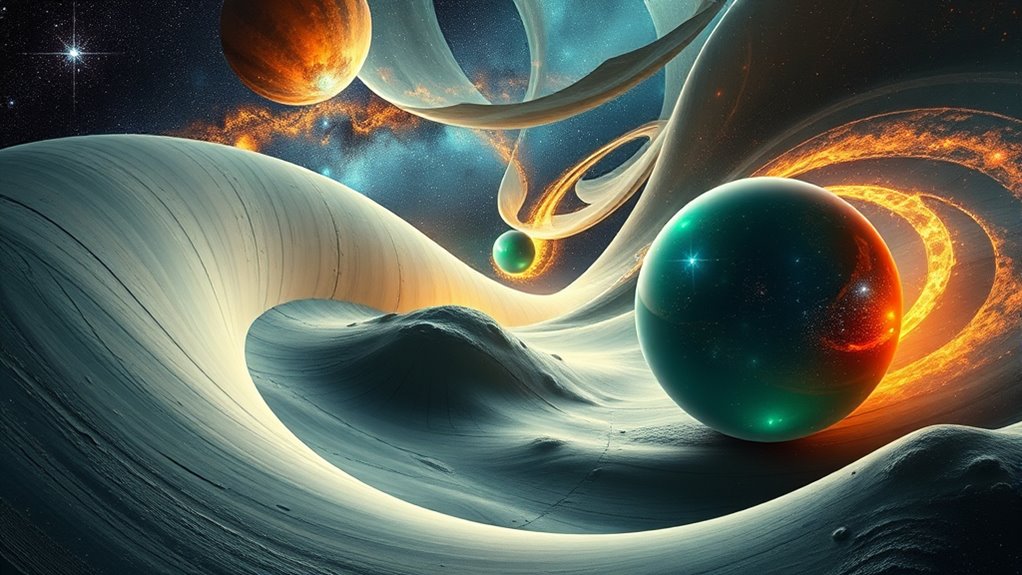
Have you ever wondered how scientists determine the shape of the universe? Non-Euclidean geometry plays an essential role in cosmology by explaining cosmic curvature. It helps you understand:
- How the universe’s shape influences light paths, fundamental for extraterrestrial navigation.
- The way large-scale structures, like galaxy clusters, reflect hyperbolic or elliptic geometries.
- Its connection to quantum gravity, which aims to unify general relativity with quantum mechanics, shaping our understanding of spacetime.
- The way geometric principles are applied in analyzing cosmic microwave background data and galaxy distributions.
These geometric insights allow you to interpret cosmic microwave background data and galaxy distributions more accurately. They also help refine models of the universe’s expansion. Non-Euclidean geometry becomes a key tool in deciphering the universe’s true structure and evolution.
Mathematical Models and Representations

Mathematical models provide the foundation for understanding non-Euclidean geometries in cosmology. You use coordinate transformations to shift between different representations of space, revealing the underlying structure. These transformations help visualize how distances and angles change in hyperbolic or elliptic geometries. Metric tensors are essential tools—they define how to measure lengths and angles within these curved spaces. By analyzing the metric tensor, you can understand how space itself is warped, influencing the behavior of objects and light. These models allow you to translate complex non-Euclidean concepts into mathematical language, making them accessible and applicable in cosmological contexts. Vetted – Mother Baby Kids Overall, coordinate transformations and metric tensors form the backbone of representing and exploring the intricate geometry of our universe.
Challenging Intuition: Parallels and Angles

In non-Euclidean geometries, the behavior of parallels and angles often defies your everyday intuition. Unlike Euclidean geometry, where the parallel postulate states that through a point not on a line, only one parallel exists, this isn’t true in hyperbolic or elliptic spaces. Here, the angle sum of a triangle varies:
- In hyperbolic space, the angle sum is less than 180°, and lines that seem parallel diverge.
- In elliptic geometry, the angle sum exceeds 180°, and all lines eventually intersect.
- The parallel postulate’s alteration causes these differences, challenging your familiar understanding of angles and lines.
- Recognizing these fundamental differences helps deepen the understanding of non-Euclidean geometries that reshape your spatial intuition.
The Impact on Art, Architecture, and Design

The unconventional properties of non-Euclidean geometry open new creative possibilities in art, architecture, and design. You can create optical illusions that challenge perception, making surfaces appear warped or infinite. Architects utilize hyperbolic and elliptic forms to craft structures that seem to defy gravity, inspiring awe. In music and visual design, the principles of musical harmony blend with geometric forms to produce immersive experiences. Below is a simple comparison:
| Feature | Impact |
|---|---|
| Optical illusions | Creates mind-bending visual effects |
| Architectural forms | Develops structures with non-traditional shapes |
| Musical harmony | Inspires designs that resonate visually and sonically |
Additionally, understanding the costs and security involved in payment processing can inform how creative projects are funded and protected.
Frequently Asked Questions
How Does Non-Euclidean Geometry Influence Our Understanding of the Universe’s Shape?
You see, understanding the universe’s shape depends on its topology and cosmic curvature. Non-Euclidean geometry shows you that space can be curved, either hyperbolic or elliptic, altering your view of the cosmos. This helps you realize the universe might be infinite or closed, shaping your perspective on cosmic expansion and the universe’s overall structure. It’s a profound way non-Euclidean geometry influences your understanding of space itself.
Can Non-Euclidean Principles Be Applied to Quantum Physics or Particle Behavior?
You might wonder if non-Euclidean principles apply to quantum physics. In fact, concepts like quantum entanglement and complex particle trajectories suggest that space at tiny scales isn’t strictly Euclidean. Non-Euclidean geometry helps visualize these ideas, showing how particles can be interconnected beyond classical constraints. While still theoretical, applying these principles could deepen our understanding of quantum behavior, revealing a universe where space itself bends and warps at quantum levels.
What Are the Implications of Hyperbolic and Elliptic Geometries for Navigation Systems?
You might wonder how hyperbolic and elliptic geometries impact navigation systems. These geometries influence GPS accuracy and route planning because they challenge traditional flat-earth assumptions. When you use GPS, understanding these geometries can improve precision, especially over long distances or in complex environments. By applying principles from non-Euclidean geometry, navigation systems can better account for Earth’s curvature, leading to more reliable directions and optimized routes for your journeys.
How Do Non-Euclidean Geometries Relate to Higher-Dimensional Spaces?
Ever wondered how non-Euclidean geometries connect to higher-dimensional spaces? You explore higher dimensional manifolds by using geometric embeddings, which allow these complex geometries to be represented within more familiar spaces. This relationship helps scientists understand phenomena beyond our intuitive three dimensions, influencing fields like physics and computer graphics. By studying these embeddings, you can grasp how non-Euclidean principles extend into higher dimensions, revealing a richer, more intricate universe.
Are There Practical Uses of Non-Euclidean Geometry in Computer Science or Virtual Reality?
You can use non-Euclidean geometry in computer science, especially in virtual reality and data visualization. It helps create more immersive environments by simulating curved spaces, giving users a sense of exploring hyperbolic or elliptic worlds. This technique enhances virtual reality experiences and allows for complex data visualizations that reveal hidden patterns. Applying these geometries makes digital worlds feel more realistic and engaging, opening new possibilities for innovation.
Conclusion
Think of non-Euclidean geometry as a vast, uncharted ocean where your intuition is your compass. By exploring hyperbolic and elliptic worlds, you expand your understanding of space beyond flat maps. These geometries open new perspectives, much like discovering hidden islands in a sea of possibilities. Embrace the journey, knowing that each discovery reshapes your view of the universe, revealing the beautiful complexity woven into the fabric of reality itself.

